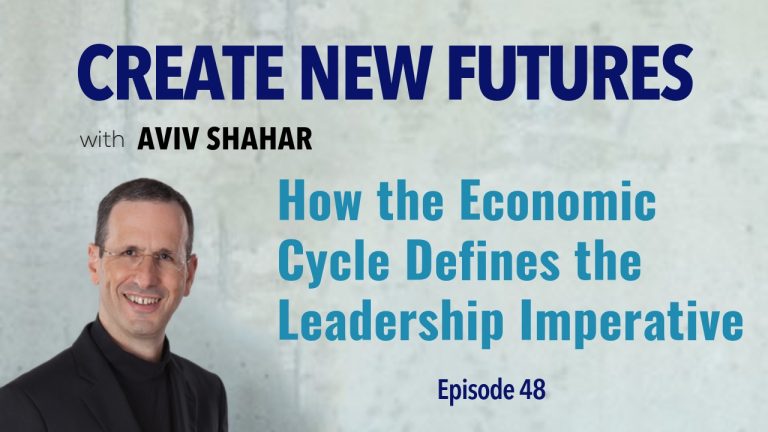Hi Leader,
In this key we will reflect on three leadership imperatives and explain how their primacy fluctuates in the context of the economic cycle.
As a result of having worked with Fortune 500 companies for 20 years, I am a vigilant observer of senior executives' promotion decisions. In the past two years, I have noticed an important trend: the leadership imperative and competence, most highly rewarded by promotion is operational prowess.
Examining this observation in the context of the economic cycle allows us to explore a possible correlation, and perhaps even causation, between the rise to prominence of a given leadership imperative and the stage of a given cycle. The three leadership imperatives we address here are strategic innovation, operational excellence, and people development.
How the Economic Cycle Defines the Leadership Imperative

Listen Here: Episode 48: How the Economic Cycle Defines the Leadership Imperative
The pendulum of leadership focus on these three imperatives tends to be synchronized with broader technology trends and economic cycles. The introduction of new and transformative technologies often coincides with, and even shapes, the economic cycle. A new cycle begins after the previous one reaches an exhaustion threshold with high levels of debt. Once the high debt levels have been cleared, a new economic and bull cycle can begin. Such cycles run their course in about 8 years.
The beginning of an economic cycle is all about big opportunities, new technologies, and addressing new markets and categories with huge possibilities. When a new platform technology initially comes online (think: railways, interstate roads, cable TV, the internet, mobile phones, and the Cloud), the focus naturally is on strategic innovation. There is a demand for creative, visionary leaders who can unleash the potential of the new platform. The mandate is for leaders who can imagine the new applications, disrupt the market, and create an innovative advantage that's hard to replicate. Those who demonstrate the competencies of strategic leadership are rewarded for their foresight and for breakthrough ideas that address value creation opportunities and meet or exceed customer needs.
In the late phases of the cycle, as the economic expansion increasingly is driven by debt creation, the leadership focus tends to swing to operational rigor and efficient execution. At this stage, the shift in emphasis to successful execution of the new platforms highlights the importance of operational excellence. The demand then is for leaders who are able to execute the innovative visions and deliver on the massive promises made in previous years.
The third essential leadership imperative is people development. To build sustained and scalable success, you must invest in people. Thus, demand is high for those who can inspire and engage the workforce, regardless of the stage of a given economic cycle or technology trend.
The global economy, including the U.S. economy, now is in year 9 of an extended bull cycle that started during 2009 after the great recession.
Economists don't have a crystal ball, and neither do I. However, my front row seat in a dozen Fortune 100 and mid-size companies that have used our services has allowed me to become a keen observer of the market and its effect on the changing demand for the three leadership competencies. One obvious trend that has gained momentum in the last few years is the primacy of operational leadership.
Companies today want people who can take great ideas and make them happen. They are keen on execution, and on driving an efficient and disciplined enterprise. Leaders who can meet these criteria are promoted and rewarded.
Here are a few of the competencies in each of these three leadership imperatives. Evaluate your proficiency in each one, identify your strengths and weakness, and determine where you will invest in your personal and professional development to catalyze your growth.
Strategic leadership:
- Imagine growth possibilities
- Connect the dots and develop insights
- Accelerate innovation
- Frame clear alternatives and meaningful choices
- Apply an integrated set of choices to create an impact
Operational leadership:
- Pull the levers that move the needle
- Diagnose and address gaps
- Develop sustained solutions and systems
- Build measures of accountability
- Mobilize a disciplined action
- Remove obstacles and eliminate distractions.
People development leadership:
- Foster talent
- Cultivate a learning culture
- Nurture an inspiring and energizing work environment
- Foster broad diversity
- Build the next generations of leaders
Reflection questions:
- Which of the above 16 bullets represent strengths and passionate activities for you?
- What development opportunities will you address today?
- Where will you invest resources to build your operational prowess?
- What hard prioritization decisions must you make right now?
Now it's your turn. Turn the key. Focus on shaping the future by building your operational prowess and cultivating the critical competencies of the leadership imperatives.

